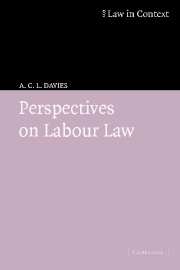Book contents
- Frontmatter
- Contents
- Preface
- Acknowledgements
- Table of statutes
- Table of statutory instruments
- Table of conventions and foreign legislation
- Table of cases
- Abbreviations
- Part I
- 1 A brief history of labour law
- 2 Economics perspectives on labour law
- 3 Human rights perspectives on labour law
- 4 Modes of regulation
- Part II
- What next?
- Index
1 - A brief history of labour law
Published online by Cambridge University Press: 06 January 2010
- Frontmatter
- Contents
- Preface
- Acknowledgements
- Table of statutes
- Table of statutory instruments
- Table of conventions and foreign legislation
- Table of cases
- Abbreviations
- Part I
- 1 A brief history of labour law
- 2 Economics perspectives on labour law
- 3 Human rights perspectives on labour law
- 4 Modes of regulation
- Part II
- What next?
- Index
Summary
Labour lawyers today commonly think about their subject using ideas about workers' rights, economic efficiency for firms or for the market as a whole, or social justice for workers. These ideas are not new. But they did not play a major role in the early history of labour law. In the 1950s, labour lawyers used sociology to make sense of their subject. This chapter will explain how rights and economics – the two key perspectives to be used in this book – started to feature more commonly in labour lawyers' thinking in the 1970s, and attained the central place they have today. It will also demonstrate the importance of using more than one perspective to understand the law.
Collective laissez-faire – the 1950s
The work of Otto Kahn-Freund has exercised, and continues to exercise, a considerable degree of influence over labour lawyers' thinking. Writing in the 1950s, he drew heavily on industrial relations theory – a branch of sociology – in order to understand the law. This was essential because anyone using a ‘black-letter’ approach – in other words, looking solely at the legal materials – would have acquired a wholly misleading knowledge of the relationship between employers and employees. For example, there were few legal controls on the circumstances in which employees could be dismissed. At common law, the contract of employment could be terminated if the employer gave notice. The courts did not inquire into whether or not the employer had a good reason for the dismissal.
- Type
- Chapter
- Information
- Perspectives on Labour Law , pp. 3 - 18Publisher: Cambridge University PressPrint publication year: 2004

